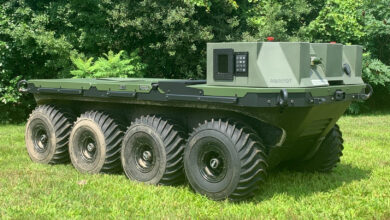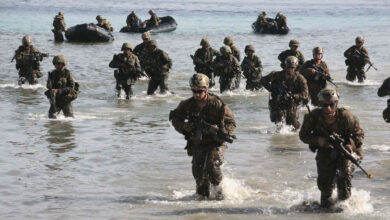
It is no secret that Sikorsky’s (Lockheed Martin) CH-53K King Stallion program has some issues to overcome. Rising costs and mechanical problems have been the program’s characteristics. While many military aircraft programs encounter such challenges during development, there is perhaps a more pressing concern facing the Marine Corps’ future heavy-lift solution.
As a former Marine Major, I can certainly appreciate the need for heavy-lift capabilities. A new platform is needed, especially with the current fleet of CH-53E helicopters quickly being relegated to the boneyard.
With a price tag per unit higher than the F-35, the CH-53K — approximately $138 million per aircraft — costs about three times that of its predecessor the CH-53E, which costed roughly $45 million per aircraft ($24.36 million in 1992 adjusted for inflation).
Hot and Heavy! The CH-53K King Stallion is meeting test challenges in the desert of Yuma this summer: operating in the dirt, lifting loads and impressing the #Marines that will be using it in the future fight. #NothingStopstheK #ChargingForward pic.twitter.com/zue6Ijuh1s
— NAVAIR (@NAVAIRNews) August 24, 2020
In the Marine Corps Vision and Strategy 2025, the Corps identified the need for force projection and deploying wherever and whenever needed. The Corps said the following regarding its committed focus on executing sustainable expeditionary operations:
“We will ensure that we maintain the ability to sustain ourselves in operations through the use of either a sea base or an initial lodgment ashore. The organic sustainability of our Marine air-ground task forces (MAGTFs) is a unique and critical force enabler in such conditions, particularly early in an operation. We must remain committed to fielding sustainable forces, exploiting joint capabilities, and leveraging the advantages of seabasing.”
Helicopters are part of this force projection; however, with such a high cost per unit, one must question if the expense is justified. Payload capacity is one example where the price seems too high.
CH-35K’s Payload Capacity and Marine Corps’ Structure
The CH-53K has an advertised payload capacity of 36,000 pounds. Let’s look at some typical loads the platform may carry. An Up-Armored Joint Light Tactical Vehicle is 22,600 pounds. A Light Armored Vehicle is 21,000 to 31,000 pounds. And an M777 Howitzer is 9,300 pounds.
While the Light Armored Vehicle nears the max payload, other systems are much lighter and perhaps could be transported by a much more cost-effective platform. The maximum payload capacity of the CH-53K’s predecessor is about 35,000 pounds. This slight increase in payload capacity doesn’t seem enough to justify CH-53K’s price tag.
It is important to remember the Marine Corps has recently identified a need to rethink its structure. In October 2019, the Commandant, General David Berger, stated that the world had forced the Corps to “throw out old assumptions and start fresh.”
Over the next 10 years, the Corps plans to make several reductions in its force. All tanks are to be removed. Infantry battalions will decrease from 24 to 21. Artillery batteries will significantly reduce from 21 to 5. Amphibious vehicle companies will go from 6 to 4. Finally, F-35B/C squadrons will shrink from 16 aircraft per unit to just 10.
While the CH-53K has some impressive specifications on paper, it would appear that the Marine Corps’ reshaping would not require such a robust replacement for the CH-53E.
Beyond what appears to be an overly priced aircraft years behind its planned operational date, perhaps the more significant concern is the modern battlefield’s ever-changing environment.
Today’s Battlefield
The United States spends roughly 15 percent of all federal spending on defense. In 2020 that was approximately $732 billion. This staggering number is more than that of China, Russia, India, Brazil, France, Germany, Saudi Arabia, Japan, the United Kingdom, and South Korea combined.
With the US Intelligence Community identifying China and Russia as the country’s main threats, American military strategy needs to prepare for potential conflict with these nations.

As the world changes, technology continues to alter the way countries handle armed conflict. In its push to modernize its military, China has particularly focused on the need for artificial intelligence, drones, and cyberspace capabilities. For example, according to a United States Defense Intelligence Agency report, China’s military strategy said the following regarding cyberspace:
“Cyberspace has become a new pillar of economic and social development, and a new domain of national security. As international strategic competition in cyberspace has been turning increasingly fiercer, quite a few countries are developing their cyber military forces. Being one of the major victims of hacker attacks, China is confronted with grave security threats to its cyber infrastructure.
“As cyberspace weighs more in military security, China will expedite the development of a cyberforce, and enhance its capabilities of cyberspace situation awareness, cyber defense, support for the country’s endeavors in cyberspace and participation in international cyber cooperation, so as to stem major cyber crises, ensure national network and information security, and maintain national security and social stability.”
Artificial intelligence and inexpensive yet highly effective weapons like drones and drone swarms are becoming very important to the Chinese military. While drone swarms are still in development, it is not unreasonable to think they will be functional by the current date for the CH-53K to be fully operational, between 2023 and 2024.
The Drone Threat
China dominates much of the drone industry. For example, one Chinese company, DJI, controls the consumer drone market with 77 percent of the market share. Both the United States Army and Air Force have also identified drones as a rising threat to the military.
Drone countermeasures are coming online but are not yet fully proven. Many are designed for engaging numerous targets but cannot counter swarms of drones operating together through complex artificial intelligence algorithms.
Future battlefields for the United States will be unlike the battlefields of the past. Technology will play an important role in military strategy, even more so than today. Successfully meeting the challenges of future conflicts demands a greater focus now on emerging threats like those in development by China, Russia, Iran, and terrorist organizations.
As the United States looks to maintain military power worldwide, there needs to be a greater concentration of resources on emerging threats. Programs like the CH-53K appear to be too expensive for the fight that is to come.
There is still a need for heavy-lift capability, but planners should seek much less expensive platforms that can still accomplish the mission. The focus should be on emerging threats instead of technology more suited for past conflicts.
 David Daly is a graduate of the United States Naval Academy and former United States Marine Corps officer. He currently is a consultant to the airspace industry and runs a commercial UAV company (Vigilante Drones) and a non-profit (Vigilante Cares) which uses drones to help military veterans with Post-Traumatic Stress Disorder (PTSD).
David Daly is a graduate of the United States Naval Academy and former United States Marine Corps officer. He currently is a consultant to the airspace industry and runs a commercial UAV company (Vigilante Drones) and a non-profit (Vigilante Cares) which uses drones to help military veterans with Post-Traumatic Stress Disorder (PTSD).
Disclaimer: The views and opinions expressed here are those of the author and do not necessarily reflect the editorial position of The Defense Post.
The Defense Post aims to publish a wide range of high-quality opinion and analysis from a diverse array of people – do you want to send us yours? Click here to submit an op-ed.











